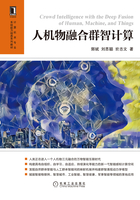
参考文献
[1] 刘云浩.群智感知计算[J].中国计算机学会通讯,2012,8(10):38-41.
[2] GUO B, WANG Z, YU Z, et al. Mobile crowd sensing and computing: The review of an emerging human-powered sensing paradigm[J]. ACM Computing Surveys (CSUR), 2015, 48(1): 1-31.
[3] 李天慈,赖贞,陈立群,等.2020年中国智能物联网(AIoT)白皮书[J].互联网经济,2020(03):90-97.
[4] 罗军舟,何源,张兰,等.云端融合的工业互联网体系结构及关键技术[J].中国科学:信息科学,2020,50(02):195-220.
[5] 李国杰.创新求索录:第二集[M].北京:人民邮电出版社,2018.
[6] BAHETI R, GILL H. Cyber-physical systems[J]. The Impact of Control Technology, 2011, 12(1): 161-166.
[7] BENI G, WANG J. (1989) Swarm intelligence[C]//Proceedings for the 7th Annual Meeting of the Robotics Society of Japan, 1989: 425-428.
[8] LI W, WU W, WANG H, et al. Crowd intelligence in AI 2.0 era[J]. Frontiers of Information Technology & Electronic Engineering, 2017, 18(1): 15-43.
[9] MICHELUCCI P, DICKINSON J L. The power of crowds[J]. Science, 2016, 351(6268): 32-33.
[10] RAHWAN I, CEBRIAN M, OBRADOVICH N, et al. Machine behaviour[J]. Nature, 2019, 568(7753): 477-486.
[11] LI SG, BATRA R, BROWN D, et al. Particle robotics based on statistical mechanics of loosely coupled components[J]. Nature, 2019, 567(7748): 361-365.
[12] KENNEDY J. Swarm intelligence[M]. Boston: Springer, 2006: 187-219.
[13] SUMPTER D J T. Collective animal behavior[M]. Princeton: Princeton University Press, 2010.
[14] WERFEL J, PETERSEN K, NAGPAL R. Designing collective behavior in a termite-inspired robot construction team[J]. Science, 2014, 343(6172): 754-758.
[15] PFEIFER R, LUNGARELLA M, IIDA F. Self-organization, embodiment, and biologically inspired robotics[J]. Science, 2007, 318(5853): 1088-1093.
[16] NEFTCI E O, AVERBECK B B. Reinforcement learning in artificial and biological systems[J]. Nature Machine Intelligence, 2019, 1(3): 133-143.
[17] WANG J X, KURTH-NELSON Z, KUMARAN D, et al. Prefrontal cortex as a meta-reinforcement learning system[J]. Nature Neuroscience, 2018, 21(6): 860-868.
[18] KULKARNI T D, NARASIMHAN K, SAEEDI A, et al. Hierarchical deep reinforcement learning: Integrating temporal abstraction and intrinsic motivation[J]. Advances in Neural Information Processing Systems, 2016, 29: 3675-3683.
[19] ZHOU Z, CHEN X, LI E, et al. Edge intelligence: paving the last mile of artificial intelligence with edge computing[J]. Proceedings of the IEEE, 2019, 107(8): 1738-1762.
[20] KANG Y, HAUSWALD J, GAO C, et al. Neurosurgeon: collaborative intelligence between the cloud and mobile edge[J]. ACM SIGARCH Computer Architecture News, 2017, 45(1): 615-629.
[21] CULLY A, CLUNE J, TARAPORE D, et al. Robots that can adapt like animals[J]. Nature, 2015, 521(7553): 503-507.
[22] RUBENSTEIN M, CORNEJO A, NAGPAL R. Programmable self-assembly in a thousand-robot swarm[J]. Science, 2014, 345(6198): 795-799.
[23] FINN C, ABBEEL P, LEVINE S. Model-agnostic meta-learning for fast adaptation of deep networks[C]//International Conference on Machine Learning. PMLR, 2017: 1126-1135.
[24] MCMAHAN B, MOORE E, RAMAGE D, et al. Communication-efficient learning of deep networks from decentralized data[C]//Artificial Intelligence and Statistics. PMLR, 2017: 1273-1282.
[25] JADERBERG M, CZARNECKI W M, DUNNING I, et al. Human-level performance in 3D multiplayer games with population-based reinforcement learning[J]. Science, 2019, 364(6443): 859-865.
[26] GUO B, LI J, ZHENG V W, et al. Citytransfer: transferring inter-and intra-city knowledge for chain store site recommendation based on multi-source urban data[J]. Proceedings of the ACM on Interactive, Mobile, Wearable and Ubiquitous Technologies, 2018, 1(4): 1-23.
[27] YANG Q, ZHANG Y, DAI W, et al. Transfer learning[M]. Cambridge: Cambridge University Press, 2020: 328-330.
[28] 郭斌.论智能物联与未来制造——拥抱人机物融合群智计算时代[J].人民论坛·学术前沿,2020(13):32-42.
[29] 郭斌,仵允港,王虹力,等.深度学习模型终端环境自适应方法研究[J].中国科学:信息科学,2020,50:1629-1644.
[1]http://www.cas.cn/zt/hyzt/ysdh19th/。
[2]https://www.gartner.com/smarterwithgartner/gartner-top-10-strategic-technology-trends-for-2020/。